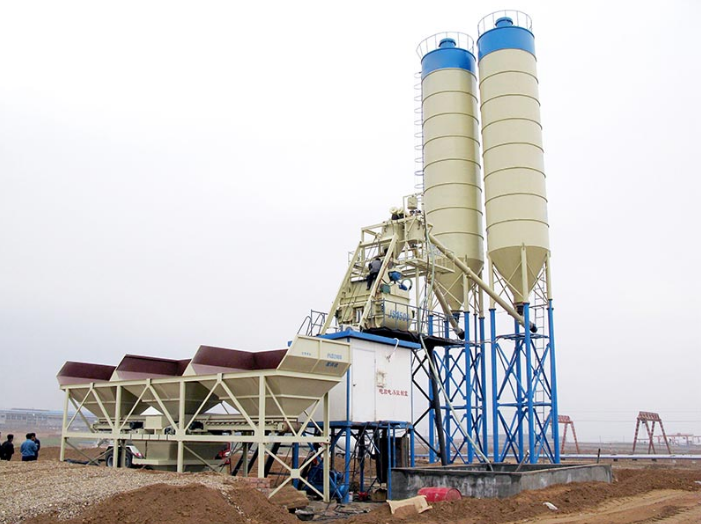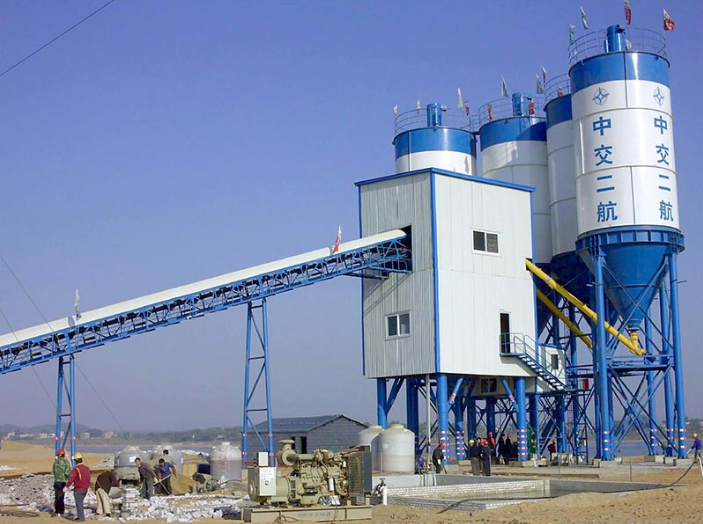What Is Stationary Concrete Plant?
Concrete batching plants serve as modern production facilities dedicated to creating concrete for numerous construction applications, focusing on precise weighing and homogeneous mixing. According to online resources, these facilities have evolved significantly, providing enhanced automation and increased production capabilities.
Concrete in concrete plants is manufactured through a systematic process that involves the precise blending of aggregates, cement, water, and additives based on predetermined recipes. This mixture is then dynamically and thoroughly mixed by high-performance concrete mixers located within the batching plants.
Initially, when concrete plants were designed, they were primarily stationary. However, advancements in technology have led to considerable improvements in stationary concrete plants over the years.
A stationary concrete plant generally comprises the following units:
1. Aggregate Bunker (unit for storing aggregates)
2. Aggregate Weighing Conveyor (unit for precise weighing of aggregates under the aggregate bunker)
3. Aggregate Transfer Conveyor or Aggregate Transfer Bucket (unit that carries the weighed aggregate to the mixer)
4. Cement Silo (unit for storing cement)
5. Cement Screw (unit that conveys cement from the cement silo to the cement scale)
6. Cement-Water-Additive Scales (units for precise weighing of cement, water, and additives)
7. Mixer (a mixer in which the weighed materials are mixed homogeneously and quickly)
8. Main Chassis (the unit containing the mixer and cement-water-additive scales, equipped with carrier legs for a transmixer)
9. Control Cabinet and Computerized Fully Automatic Control System (automatically manages concrete production based on recipes)
10. Air Compressor and Pneumatic Equipment (produces compressed air essential for the facility's operation)
These components work synergistically to ensure efficient and automated concrete production adhering to predefined recipes.
What are the Advantages of Stationary Concrete Plant?
Modern stationary concrete batching plants are expertly designed to provide multiple benefits, with an emphasis on maximizing capacity, flexibility, efficiency, and reliability. These facilities are capable of consistently producing various high-quality concrete types in substantial quantities.
The Advantages of Stationary Concrete Plant are:
1. High Production Capacity and Performance: This type of plant can produce a wide variety of concrete, with operational capacities from 30 m³/h to 200 m³/h (up to 400 m³/h with dual mixers), ensuring maximum performance.
2. High Configuration Flexibility: It presents flexible structural designs and configuration alternatives tailored to user specifications.
3. Special Settlement Opportunities: Various installation area alternatives can be provided to meet specific needs.
4. Durable and Long-Life Design of Main Chassis and Aggregate Bunker: Built with robust materials, it guarantees safe transportation, extended operational life, and reduced vibration, promoting precise weighing.
5. Easy and Fast Maintenance: Designed with comprehensive maintenance platforms facilitating safe and straightforward access to key components, including the mixer and weighing scales.
6. Specialized Concrete Production Facility: Ideal for crafting various concrete types such as RCC, concrete parquet, concrete pipes, and prefabricated structures.
7. Versatile Concrete Production Options: Accommodates a variety of concrete production types such as age type, dry type, wet type, and hybrid (both wet & dry) operations.
Applications of Stationary Concrete Plants:
Ready-mixed concrete providers, who manufacture concrete in-house to supply other construction enterprises and concrete users, frequently select stationary concrete plants for their capabilities in large-scale production, high efficiency, and adaptability.
Stationary concrete plants are particularly favored in projects demanding high-quality concrete, including road construction, dams, airports, and any endeavors requiring premium concrete solutions. Furthermore, these plants are widely used in specialized concrete manufacturing processes, such as producing RCC (Roller Compacted Concrete), concrete parquet, concrete pipes, prefabricated components (like columns and beams), and hollow concrete floors.
Stationary Concrete Plant Features:
The adaptable configuration of stationary concrete plants ensures design options that can effectively meet user requirements in various forms.
In stationary concrete facilities, aggregates are moved to the mixer via either an aggregate transfer conveyor or an aggregate bucket, the latter being preferable in tight spaces due to its steeper angle. Typically, aggregate transport involves a transfer conveyor, and in setups utilizing this method, the aggregate waiting bunker is positioned above the mixer.
For efficiency, the aggregate needed for a production cycle is continuously stored in the aggregate waiting bunker, ready to be dispatched to the mixer as needed. This separation between aggregate transfer and mixing minimizes cycle duration and enhances concrete output capacity.
In some fixed concrete plant models, both the primary chassis (supporting the mixer) and the aggregate bunker can feature a hot-dip galvanized finish, ensuring longevity, durability, and heightened weighing precision.
Using separate weighing frames for cement, water, and additives instead of integrating them into the mixer enhances weighing accuracy.
While stationary concrete plants typically operate as wet types, they may also be designed as dry types or hybrid (wet & dry) types. Additional features such as dual transmixer discharge capabilities and supplementary weighing scales for ice, microsilica, GGBS, and other elements can be incorporated as well.



Comments